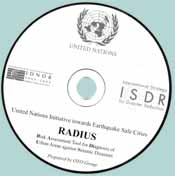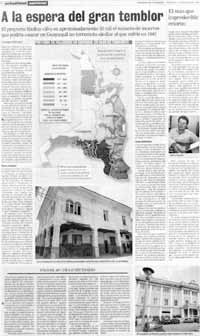|
Review
of the Impact of the Risk Assessment Tools for Diagnosis of Urban Areas
against Seismic Disasters (RADIUS) Project
Background
 In
1996, the Secretariat of the International Decade for Natural Disaster
Reduction (IDNDR) launched the RADIUS initiative. The main mission of
this three- year program was to promote worldwide activities for the reduction
of seismic disasters in urban areas, particularly in developing countries.
The primary goal of RADIUS was to help people understand the seismic risk
and raise public awareness at the city level, in the form of long-term,
institutionalized programs to manage earthquake risk The direct objectives
were: In
1996, the Secretariat of the International Decade for Natural Disaster
Reduction (IDNDR) launched the RADIUS initiative. The main mission of
this three- year program was to promote worldwide activities for the reduction
of seismic disasters in urban areas, particularly in developing countries.
The primary goal of RADIUS was to help people understand the seismic risk
and raise public awareness at the city level, in the form of long-term,
institutionalized programs to manage earthquake risk The direct objectives
were:
- To develop earthquake
damage scenarios and action plans in nine case-study cities selected
world-wide;
- To conduct a comparative
study to understand urban seismic risk around the world, and;
- To promote information
exchange for seismic risk mitigation at the city level; and
- To develop practical
tools for seismic risk management, which could be applied to any earthquake
prone city in the world.
The results of applying
the tools to be developed were to be useful for decision makers and government
officials, who are responsible for disaster prevention, as well as for
communities, NGO’s, and citizens. The project compriseds different
categories: case- study(1), member(2) and associate(3) cities. , as well
as individuals and institutions, and RADIUS team members. The case-study
cities were Addis Ababa (Ethiopia), Antofagasta (Chile), Bandung (Indonesia),
Guayaquil (Equador), Guayaquil (Equador), Izmir (Turkey), Skopje (TFYR
Macedonia), Tashkent (Uzbekistan), Tijuana (Mexico), and Zigong (China)Antofagasta
(Chile), Bandung (Indonesia), Izmir (Turkey), and Skopje (TFYR Macedonia).
The RADIUS initiative
was completed in 1999 and the Secretariat of the International Strategy
for Disaster Reduction (ISDR), the successor arrangement to the IDNDR
Secretariat, published the summary report and produced the CD-ROM, containing
all the final reports and the tools developed through the initiative(4).
In order to assess
the impact of the RADIUS case studyproject, a review was performed inon
the nine case-study cities .in which RADIUS implemented full case studies
This review, conducted one year after the completion of the project, indicated
that RADIUS was an important contribution to risk management initiatives
in those cities(5).
 Review
of the impact of the RADIUS project Review
of the impact of the RADIUS project
Two years after the
completion of the project, another review was conducted in February 2002;
this time among all the participating citiescategories (case-study, member,
and associate cities) as well as the individuals and institutions who
were involved in the project or who received the CD-ROM, and the RADIUS
expert team members.
The main objectives
of this review were:
- To estimate the
actual impact of the RADIUS project;, the
- To reactivate
the global network of city representatives that was created during the
implementation of RADIUS;, and the
- To identify needs
and gathering of ideas, options, and potential official support for
the continuation of RADIUS related activities.
The review concentrated
on studying three specific areas: a) advances in risk management in the
cities that participated in the project, b) utilization and usefulness
of the practical tools produced by the project, and c) future initiatives
to promote risk management. The review produced the following results:
- The review of
the advances in risk management in the cities looked at the use of project
activities generated by RADIUS, and the main constrains for risk management
activities. The use of the Earthquake Scenarios and Risk Management
Action Plans generated the greatest amount of interest and awareness,
and resulted in the largest number of concrete actions in the case-
study cities, while a limited use of the activities in the member cities,
and no use of the activities in the associate cities. For instance,
in the case-study city of Tijuana, a permanent program was initiated
to implement the RADIUS produced action plan carrying the name of RADIUS,
while the city of Antofagasta prepared a new Regulatory Plan and revised
the City Emergency plan based on RADIUS. This suggests that a relatively
extended time of presence and interactive work of international experts
is useful to generate the necessary momentum for continuation.
Other new initiatives
reported by the cities included regulation and planning programs implemented
by local authorities, creation or strengthening of local institutions,
and the application of the RADIUS methodology to neighboring cities.
Antofagasta, for example, supported the creation of an NGO that would
coordinate risk management activities in other cities. Again, the
case-study cities where much more active than other cities. The main
constraints for risk management activities were created by the lack
of financial resources, and the lack of awareness and commitment of
the local authorities. As the most important part of the financial
resources is community based, the lack of awareness posed a serious
problem.
- The review of
the utilization and usefulness of the practical tools produced by the
project looked at the dissemination of the RADIUS tools, applications
and usefulness of the RADIUS tools, and possible modifications. The
international dissemination of the material was relatively effective,
but the local dissemination was rather ineffective. The RADIUS cities
used the tools in a limited scale and for purposes that are different
from the ones for which the tools were designed, for example, only 6
% of the cities used the tools to increase public awareness. Most of
the representatives found the tools easy to use, although 30 % indicated
that some additional guidance would be very useful. Suggestions for
possible modifications included greater flexibility of the tools for
a better adjustment to local conditions. Several earthquake specialists
pointed out, for instance, that the tool was too general and simplistic,
but one should keep in mind that RADIUS was designed to produce quick,
rough earthquake damage estimates that should be used to raise public
awareness but could not replace more precise studies.
- The review of
the future initiatives to promote risk management proposed three possible
initiatives under consideration, (Are the following the 3 initiatives
under consideration?) comparison of the relative risk among cities,
a global database of urban earthquake risk, and a RADIUS network of
cities. The majority of the participants (70 %) thought a comparison
among cities would be useful, but would not ignite action. The other
30 % pointed out that local people would not learn anything from such
a comparison, and that the main beneficiaries would be the international
organizations and not the cities.
 The
global database of urban earthquake risks received the support of 89 %
of the participants, and the initiative was considered to be attractive
and potentially useful. The RADIUS network of cities was approved unanimously
and enthusiastically. Furthermore, the participants gave numerous other
suggestions, covering the following main categories: a) increase of awareness
of the existing risk and available solutions, b) application of the RADIUS
experience to other cities and adaptation of the radius methodology, c)
provision of support to local initiatives and people, and d) promotion
of the implementation of specific risk management action in cities worldwide. The
global database of urban earthquake risks received the support of 89 %
of the participants, and the initiative was considered to be attractive
and potentially useful. The RADIUS network of cities was approved unanimously
and enthusiastically. Furthermore, the participants gave numerous other
suggestions, covering the following main categories: a) increase of awareness
of the existing risk and available solutions, b) application of the RADIUS
experience to other cities and adaptation of the radius methodology, c)
provision of support to local initiatives and people, and d) promotion
of the implementation of specific risk management action in cities worldwide.
The review produced
some of the following recommendations:
- A relatively extended
time of international experts is useful for the necessary momentum.
- Only local funding
can produce sustainable solutions, as international aid is too insecure
and to unstructured.
- Establish mechanisms
to ensure that RADIUS users clearly understand the characteristics,
scope, and purpose of the tools, and make sure that the tools scope
and purpose is clear to the technical community.
- Strengthen the
RADIUS network of cities, because this global community could form a
movement strong enough to catch the attention of local and international
leaders and push risk management into the domestic and international
agendas.
- Keep the RADIUS
name in future related initiatives for this name has achieved its own
identity and prestige.
- And finally, make
sure that any new initiative considers, and is in the closest possible
coordination with, existing plans and programs of local authorities
and city institutions, as well as other international initiatives.
Despite some of the
problems that were encountered during the project, there has been a significant
increaseimprovement in the management of earthquake risk in the RADIUS
cities. According to the analysis of the RADIUS project, the cities believe
that the project contributed significantly to the progress achieved in
each city. According to one of the city representatives:
‘RADIUS taught
all of us the importance of collaboration among all the concerned people
and institutions.’ (Ms. C. Rojas, City Representative, Antofagasta,
Chile).
Further information on the RADIUS project,
please contact:
isdr@un.org
or visit:
www.unisdr.org / www.eird.org
- Nine cities were
selected world-wide to carry out a 18-month case study with financial
and technical assistance.
- 74 member cities
participated in a comparative study to better understand the urban seismic
risk around the world.
- 35 cities, which
had carried out a seismic risk assessment or wer in the process of doing
so, contributed to the project through the exchange of information.
- ISDR Secretariat,
RADIUS, Risk Assessment Tools for Diagnosis of Urban Areas against Seismic
Disasters, 2000
- ISDR Secretariat,
Year-Later Evaluation of the RADIUS Case-study Cities, 2001
|




